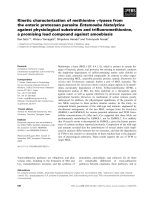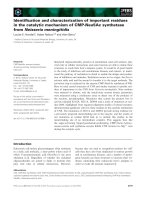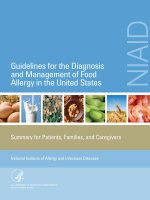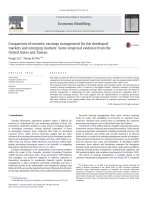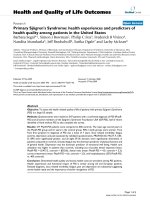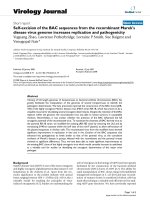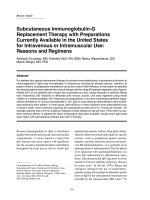Female return migration from the gulf states pre return expectations, post return experiences and prospects of voluntary returnees in ejersa lafo woreda, central ethiop
Bạn đang xem bản rút gọn của tài liệu. Xem và tải ngay bản đầy đủ của tài liệu tại đây (832.84 KB, 139 trang )
1
VOLUNTARY RETURN MIGNRATION EXPERIENCES
Running head: VOLUNTARY RETURN MIGRATION EXPERIENCES
Female Return Migration from the Gulf States: Pre-return Expectations, Post-return Experiences
and Prospects of Voluntary Returnees in Ejersa- Lafo Woreda, Central Ethiopia
A Thesis Submitted to the School of Social Work in the Partial Fulfillment of the Requirements
for the Degree of Masters in Social Work
By: Assefa Bayisa
Advisor: Adamnesh Atnafu (PhD)
June, 2017
Addis Ababa University
Addis Ababa, Ethiopia
2
VOLUNTARY RETURN MIGNRATION EXPERIENCES
Addis Ababa University
School of Graduate Studies
This is to certify that the thesis prepared by Assefa Bayisa, entitled: Female return migration
from the Gulf States: pre-return expectations, post-return experiences and prospects of voluntary
returnees in Ejersa- Lafo Woreda, and submitted in partial fulfillment of the requirements for the
degree of Master of Social Work complies with the regulations of the university and meets the
accepted standards with respect to originality and quality.
Signed by the Examining Committee:
Examiner_________________________ Signature____________ Date _____________
Examiner_________________________ Signature____________ Date _____________
Advisor _________________________ Signature____________ Date _____________
____________________________________________
Chair of Department or Graduate Program Coordinator
i
VOLUNTARY RETURN MIGNRATION EXPERIENCES
Acknowledgment
First, I would like to thank almighty God, without whose help nothing could be ever done and
completed. I would then like to thank my advisor Adamnesh Atnafu (PhD) without whose kindly
professional advice, this paper could not have been completed. I would also like to extend my
heartfelt gratitude to my friends and seniors whose critical comments have invaluably contribute to
bring this paper to fruit. Last but not least, I would like to forward my deepest gratitude to all the
study participants; this study is theirs.
ii
VOLUNTARY RETURN MIGNRATION EXPERIENCES
Table of Contents
Contents
Pages
Acknowledgment ........................................................................................................................................... i
Table of Contents .......................................................................................................................................... ii
List of Tables ................................................................................................................................................ v
List of Figures ............................................................................................................................................... v
Acronyms and Abbreviations ...................................................................................................................... vi
Abstract ....................................................................................................................................................... vii
Chapter One: Introduction ............................................................................................................................ 1
1.1 Background of the Study ................................................................................................................... 1
1.3 Objectives of the Study ..................................................................................................................... 8
1.3.1 General objective ........................................................................................................................ 8
1.3.2 Specific objectives ...................................................................................................................... 8
1.4 Research Questions ........................................................................................................................... 8
1.5 Scope of the Study ............................................................................................................................. 9
1.6 Significance of the Study................................................................................................................... 9
1.7 Definition of Terms ......................................................................................................................... 10
1.8 Organization of the Study ................................................................................................................ 11
Chapter Two: Review of Literatures ........................................................................................................... 12
2.1 Overview of Migration Processes.................................................................................................... 12
2.2 Drivers of Migration ........................................................................................................................ 14
2.3 Return Migration ............................................................................................................................. 16
2.4 Theories of Return Migration .......................................................................................................... 19
2.4.1 Neoclassical Economics and the New Economics of Labor Migration .................................... 19
2.4.2 The Structural Approach to Return Migration .......................................................................... 21
2.4.3 Transnationalism and Return Migration ................................................................................... 22
2.4.4 Social Network Theory and Return Migration.......................................................................... 23
2.4.5 Re-Acculturation Theory of Migration: Sussman‟s Cultural Identity Model ........................... 24
2.5 Return Preparedness and its Degrees............................................................................................... 26
2.5.1 Degrees of return preparedness ................................................................................................. 28
2.6 Understanding the Variety of Post Return Experiences .................................................................. 29
iii
VOLUNTARY RETURN MIGNRATION EXPERIENCES
2.7 Sustainable Return and Re-embeddedness of Returnees ................................................................. 31
2.8 Reintegration Strategies of Returnees ............................................................................................. 36
2.9 Benefits and risks of temporary labor migration to the Gulf States: Ethiopia‟s case ...................... 37
2.10 Institutional Settings and Policies on Return Migration .................................................................. 41
2.10.1
Institutional Settings ........................................................................................................... 41
2.10.2
The Diaspora Policy ............................................................................................................ 43
Chapter Three: Methodology ...................................................................................................................... 45
3.1 Introduction ..................................................................................................................................... 45
3.2 The Researcher‟s Philosophical Stance ........................................................................................... 45
3.3 Study Area and Population .............................................................................................................. 46
3.4 The Research Approach .................................................................................................................. 47
3.5 Research Design .............................................................................................................................. 49
3.6 Data Collection Methods and Procedures ....................................................................................... 50
3.6.1 In-Depth Interview .................................................................................................................... 50
3.6.2 Observation ............................................................................................................................... 51
3.7 Inclusion Criteria ............................................................................................................................. 52
3.8 Sampling Techniques and Size ........................................................................................................ 53
3.9 Data Analysis and Interpretation Procedures .................................................................................. 54
3.10 Data Quality Assurance .................................................................................................................. 56
3.11 Ethical Considerations ..................................................................................................................... 57
Chapter Four ............................................................................................................................................... 58
4.
Data Presentations and Interpretations ................................................................................................ 58
4.1 Description of the Study Participants .............................................................................................. 58
4.2 Pre-Return Expectations of the Participants .................................................................................... 66
4.2.1 Expectations Related to Economic Situations........................................................................... 66
4.2.2 Expectations Related to Social Situations in Home country ..................................................... 67
4.2.3 Expectations Related to Family Situations ............................................................................... 68
4.3 The Returnees Preparedness: Free will and Readiness to Return.................................................... 69
4.3.1 The Prepared Returnees ............................................................................................................ 70
4.3.2 The Moderately Prepared .......................................................................................................... 71
4.4 The Motives behind their Return ..................................................................................................... 73
4.4.1 To Realize their Plans ............................................................................................................... 73
iv
VOLUNTARY RETURN MIGNRATION EXPERIENCES
4.4.2 Homesickness ........................................................................................................................... 75
4.4.3 The Health Condition of their Family ....................................................................................... 76
4.4.4 The Need to Take a Rest ........................................................................................................... 76
4.5 The Participants Post-Return Experiences ...................................................................................... 77
4.5.1 Feeling of Happiness upon Arrival to Ethiopia......................................................................... 78
4.5.2 Being Engaged in Diverse Livelihood Strategies ..................................................................... 79
4.5.3 A Feeling of Discomfort towards the Working Condition in Homeland .................................. 80
4.5.3.1
Being Out of Job ................................................................................................................. 80
4.5.3.2
The Inability to Yield Fair Profit out of Businesses............................................................ 80
4.5.3.3
Family Related Problem...................................................................................................... 83
4.5.3.4
Lack of Good Governance .................................................................................................. 84
4.5.4 Opportunities Available to the Participants .............................................................................. 85
4.5.5 Challenges the Participants have Faced .................................................................................... 85
4.5.6 Limited Reintegration Back Home ........................................................................................... 89
4.5.6.1
Economic Problem: Unsuccessfulness in Rebuilding Sustainable Livelihoods ................. 89
4.5.6.2
Psychosocial Problems ........................................................................................................ 89
4.5.6.3
The Weakening of Social Networks after Return ................................................................ 91
4.6 Prospects as it is Viewed by the Participants................................................................................... 92
Chapter Five: Discussion ............................................................................................................................ 95
5.1 Over Expectation in Homeland ....................................................................................................... 95
5.2 Return Preparedness ........................................................................................................................ 96
5.3 The Varity of Return Motives ......................................................................................................... 98
5.4 The Context of Ethiopia in which Return took place: ‘…Coming from fire to Fire…’ ...................... 99
5.5 Failure to Reintegration Back Home ............................................................................................. 100
5.6 The Eagerness for Re-migration .................................................................................................... 104
Chapter Six: Conclusion and Implications................................................................................................ 106
6.1 Conclusion ..................................................................................................................................... 106
6.2 Implication for social work education, policy, practice and future researches .............................. 108
References ................................................................................................................................................. 114
Appendices................................................................................................................................................ 123
Appendix 1 :In-Depth Interview Guide for the Returnees .................................................................... 123
Appendix 2: Observation Check List ........................................................................................................ 126
v
VOLUNTARY RETURN MIGNRATION EXPERIENCES
List of Tables
Table 1 Attributes of the Research Participants .....................................................................63
Table 2 Emerged themes regarding pre-return expectations .................................................65
Table 3 Emerged themes regarding return motives ...............................................................69
Table 4 Emerged themes regarding return preparedness ......................................................72
Table 5 Emerged themes regarding the post-return experiences ...........................................77
Table 6 Emerged themes regarding prospects .....................................................................92
List of Figures
Figure 1.A conceptual model of return preparedness ............................................................28
vi
VOLUNTARY RETURN MIGNRATION EXPERIENCES
Acronyms and Abbreviations
ETB- Ethiopian Birr
ILO- International Labor Organization
IOM- International Organization for Migration
KSA- kingdom of Saudi Arabia
MFA- Ministry of Foreign Affairs
MoLSA- Ministry of Labor and Social Affairs
OECD- Organization for Economic Cooperation and Development
SIHMA -Scalabrini Institute for Human Mobility in Africa.
UAE- United Arab Emirates
UNICEF- United Nations International Children‟s and Education Fund
UNHCR-United Nations High Commissioner on Refugees
FDRE-Federal Democratic Republic of Ethiopia
vii
VOLUNTARY RETURN MIGNRATION EXPERIENCES
Abstract
Return migration is a dynamic and complex phenomenon which involves diverse participants
with different backgrounds and experiences. Espousing hermeneutic phenomenological research
design, this study utilized interviews and observation to describe and interpret pre-return
expectations, preparedness, and return motives including the post-return happenings and
accomplishments of 10 female voluntary returnees from the Gulf States to Ejersa-Lafo Woreda.
The participants were selected through snowball sampling technique. Collected data were
analyzed thematically. The findings show that although the participants had positive
expectations in their homeland, felt prepared for return and back home to realize their prior
plans, they were hardly reintegrated in all economic, psychosocial and social-network aspects.
Regardless of the type of return motives and degree of return preparedness, this study revealed
that conditions in homeland alone would enormously influence the post-return experiences of
returnees. Upon home return, the home market appeared to them difficult, their social status
declined over time and families were not found trusted as they were appeared to them before.
The inability to live up to their prior expectations and plans, made the participants not to feel at
home that, in turn, triggered their re-migration intention. Thus, the participants are susceptible
to the potential sufferings ahead of them since they are eager to reach again, even illegally, the
destination countries they came from. Alongside raising awareness of the returnees about the
potential consequences of illegal migration, social workers in collaboration with the local
government should devise means to re-embed them in their community. Money management
orientations before leaving home, and information about home situations before return should
also be provided to the migrants in order to make their reintegration not challenging.
Key terms: voluntary return, reintegration, social networks, return preparedness, Gulf States
1
VOLUNTARY RETURN MIGNRATION EXPERIENCES
Chapter One: Introduction
1.1 Background of the Study
The dynamic and chronologically successive movement of people from one geographical area to
another, either willingly or forcefully, is an integral trait of human beings upon which the history
of civilization was built: After a while the notion “movement” which connotes action was
developed into “migration” which implies place (Jamie, 2013). It can be said that migration is
part and parcel of human kind.
Multiple factors, such as environmental, political, social, and economic, may necessitate
migration. When it comes to labor market, migration is triggered by high unemployment rate
and underemployment for the blue-collars, low wages for the white-collars, and unsatisfactory
educational provisions and acquirement of skills in countries of origin (Organization for
Economic Cooperation and Development [OECD], 2009). Thus, compared to other types of
migrants, the driving factor behind labor migrants is largely economic.
Nowadays, international labor market comprises a significant number of women. More
and more women are migrating independently of men (Pinnawala, 2009). Beside the increase in
number, however, compared to their male counterparts, females are concentrated mainly in the
hidden and secondary labor markets (Anthias, 2000). This is due to a gendered labor market that
is sensitive to a gender-selective demand for labor where independent women migrants have
become the major players. For instance, two thirds of all part-time and temporary workers are
women (Pinnawala, 2009).This implies that women have mainly participated in low paying jobs,
besides their significant occupation of international migrant work force. This is mainly
manifested in Middle-East countries where the majority of migrant women work as domestic
workers.
2
VOLUNTARY RETURN MIGNRATION EXPERIENCES
Covering more than 80%, women represent the lion‟s share of people working as
domestic workers. Being a feminized sector of the economy, domestic work is characterized by a
large number of women migrants working in the field (Schewenken & Haimeshof, 2011). The
major destination countries of transnational women migrants are the Gulf Cooperation Council
[GCC] where many African and Asian women work as domestic workers. Among them, growing
number of migrant domestic workers in GCC are from Ethiopia, Eritrea, Sudan and Egypt due to
their cheap labor compared to the Asian women (Fernandez, 2010). Evidences suggest that
domestic workers are treated differently in GCC based on their respective countries rank, mainly
economic. Ethiopian women are part of this story.
Experiencing constant poverty that has been triggered by social, political, economic, and
environmental factors, Ethiopia is a country from where people desperately migrate to more
developed countries (if possible, they rather prefer to go to western countries, but if not, they go
to anywhere accessible). Either illegally, through trafficking and smuggling or legal channels,
citizens of the country continue to migrate in search of better living conditions, education and
employment (Adamnesh & Adamek, 2016). It can be said that regardless of the place they go
and the type of work awaiting them, Ethiopians eagerly migrate abroad through whatever means
available.
With 2-3 million workers entering the job market annually, the country is unable to
provide necessary livelihood opportunities, especially for the young, which is viewed as the main
driving force behind migration. Most of Ethiopian legal migrants in the Middle East are women;
mainly young and single (Carter & Rohwerder, 2016). The absence of employment prospects for
young Ethiopians associated with a high division of gender roles in the labor force participation
has produced a gendered consequence where women bear the shortfall of the employment deficit
3
VOLUNTARY RETURN MIGNRATION EXPERIENCES
by entering into the informal sector or migrating as contract domestic workers (Fernandez,
2011). This indicates the prevalence of gender based discrimination in Ethiopian labor market
which favors males over females and in turn pushes females for migration.
Majority of Ethiopian women experience abuse in one or more migration cycles; some of
them are trafficked to the Middle East through illegal routes, significant others are discriminated
and abused in the destination countries, and still many others are deported (Regt & Medareshaw,
2016; Fernandez, 2010; Regt, 2007). Thus, despite their enthusiasm to migrate to the Middle
East, usually, their expectations are unmet and things went the other side.
Following the persistent problems attached with migration to the Middle East, especially
for female domestic workers, studies have been conducted on return migration stressing on the
returnees‟ pre-return experiences and their reintegration back home(Kuschminder, 2013; Regt &
Medareshaw, 2016). However, apart from the abuses and deportations of Ethiopians that gained
relative attention, the case of labor migrants who had been working in the Gulf States and
returned home voluntarily is not given due emphasis. Thus, there is a need to study women
voluntary return.
To this end, this study intended to describe the pre-return expectations, post-return
experiences and prospects of female migrants who voluntarily returned to Ethiopia from the
Gulf- States.
1.2 Statement of the Problem
The increasing importance and complexity of migration globally implies a global increase in
return migration (Davies, Borland, Blake & West, 2011), which is part of a migration process
and defined as the act of going back to once own place of origin (International Organization for
4
VOLUNTARY RETURN MIGNRATION EXPERIENCES
Migration [IOM], 2004). Migrants return to home either voluntarily after reviewing all available
information about the conditions in their country of origin or involuntarily through expulsion.
Associated to the voluntary/ involuntary return migration dichotomy, there are different
outcomes resulted upon the returnees back home which put them in different social, cultural and
economic situations and, therefore, affect their reintegration differently. Concerning this issue,
Casarino suggested that there is a need to know “who returns when, and why; and why some
returnees appear as actors of change, in specific social and institutional circumstances at home,
whereas others do not” ( Casarino, 2004, p.254). Parallel to Cassarino‟s suggestion, Van Houte
and Davids (2008) also indicated that it is important to categorize returnees based on their return
motives which has an important implication for their post-return experiences.
Both claims argued above by the mentioned authors have strong connotations that would
divert the phenomenon of return migration from the mere conception of “going back home” to
dynamic and complex process which is characterized by divers participants with complex
backgrounds and experiences. For instance, as one aspect of return migration, recent studies on
„prepared returnees‟ demonstrate that they are more likely to contribute to development
(Kuschminder, 2013; Cassarino, 2004; 2008). According to these empirical evidences, for
returnees to contribute to their country‟s development, their return should be prepared. In
principle, prepared returnees have means for their reintegration. Here, it seems that return
preparedness is to do with voluntariness; the more the migrants are prepared, the more likely
they would voluntarily return home and reintegrated too.
Although it can be argued that “return can never be voluntary when there is no plausible
(legal) alternative” as Noll cited in Davids and van Houte (2008, p.1413) stated, a migrant with
no option to stay in destination country but to return homeland without being forcefully
5
VOLUNTARY RETURN MIGNRATION EXPERIENCES
repatriated is considered as a voluntary returnee by policy makers and NGOs (Van Houte &
Davies, 2008). However, for Cassarino, voluntary return only comprises migrants who “chose on
their own initiative to return, without any pressure or coercion” (Cassarino, 2008, p.113).
In Ethiopia, as far as labor migration, particularly of domestic workers concerned, most
of the empirical studies stresses on trafficking to and deportation from the Gulf States. Issues
related to the miseries Ethiopian maids had encountered upon their journeys to the Gulf States
(Addis, 2014; Frouws, 2014a; Beydoun, 2006) and during their stay abroad (Adamnesh &
Adamek, 2016; Jamie & Tsega, 2015; Kasahun & Mulugeta, 2015; Abebaw, 2012; Fernandez,
2010) accompanied with the related reintegration problems back home (Regt & Medareshaw,
2016; Kushminder, 2014) are at the heart of these studies.
Through their review of literature on fragility and migration in relation to Ethiopia, Carter
and Rohwerder (2016) reported that the migration journey of Ethiopian‟s to the Gulf States,
illegally, through trafficking and smuggling is risky, and accompanied with many human rights
abuses and deaths. Rape, unwanted pregnancy, and sexually transmitted infections are risks that,
usually, faced female migrants.
Kushminder (2014) citing Ethiopian female returnees from the GCC stated that different
kinds of abuses such as beatings, indentured labor, not receiving food, not receiving payment,
sexual harassment, verbal abuse, and restricted movement including burnings, beatings resulting
in hospitalization, and even death are done to the domestic workers while they were working in
the Gulf States.
In their study of the return migration experiences of Ethiopian women trafficked to
Bahrain, Adamnesh and Adamek (2016) found that migrants return mainly because of intolerable
working conditions and continued abuse. Their findings show that the returnees faced
6
VOLUNTARY RETURN MIGNRATION EXPERIENCES
reintegration difficulties for they have not accumulated enough savings while they were working
abroad, and faced misunderstandings and impractical expectations from their families and
community upon return.
On their study of the experiences of Ethiopian deportees prior, during and after their
forced return from KSA, Regt and Medareshew (2016) argued that besides inability of the
Ethiopian government to re-embed them economically, the absence of preparedness due to
sudden return impacted the economic, social network and psychosocial embeddedness of the
returnees upon back home.
Available literature searches indicate that voluntary return migration experiences were
hardly studied. As to my knowledge, there is no study conducted solely on voluntary returnees
from the Gulf States to Ethiopia. Thus, there is a need to study women voluntary return.
In fact, most of the migration story of Ethiopians, specifically of the domestic workers, is
full of tragedy (Kushminder, 2014) that necessitated for practicable empirical investigations to
be conducted. Nonetheless, as a matter of fact, as far as Ethiopian female domestic workers in
the Gulf States are concerned, return migration is not always a matter of deportation as there are
those who took own initiatives to return home. Studying the post return experiences of
voluntarily returned female domestic workers, apart from the deported, invaluably contributes to
our current knowledge of female return migration from the Gulf States. Correspondingly, this
study targets to understand the issue of migrants‟ voluntary return.
To a greater or a lesser degree, every issue has both opportunities and challenges, so does
migration. There are challenges and opportunities migrants have encountered during all the
migration process. Challenges and opportunities are there both at country of destination during
their stay abroad, and at the country of origin during their back home. Divergent from the
7
VOLUNTARY RETURN MIGNRATION EXPERIENCES
aforementioned studies that mainly studied the problems and harms the deportees encountered
both while they were in the Gulf States and after their return to Ethiopia, this research stressed
the challenges faced by and opportunities available to voluntarily returned female domestic
workers via explicating their post return experiences such as their reintegration (economic,
social-networks and psychosocial) with diverse factors influencing it. Only when we reveal the
post-return experiences of the voluntarily returned females and the meanings they attach to it, we
become aware the essence of return migration from the Gulf States. Otherwise, a conclusion that
we are going to arrive at about labor migration, specifically about domestic workers may become
partial and incomplete. Understanding the current situations of the returnees is also important to
know their future plan.
In addition, since pre-return expectations (Gmelch, 1980), return preparedness (Van
Meeteren, Engbersen, Snel, & Faber, 2014; Cassarino, 2008) and return motives (Van Houte &
Davids, 2008) have bearings on the post-return experiences of the migrants, this research
intended to describe and interpret the returnees‟ expectations in their homeland, and their
preparedness and motives for return while they were working in the Gulf States.
Lastly, studying the experiences of voluntarily returned female migrants has policy
implication. Beside rehabilitation of the deportees, it urges policy makers to consider the case of
voluntary returnees during policy initiation that will help them sustain their living. It also has
implications for social work education and practice.
Generally, the persistent nature of labor return migration from the Gulf States, the dearth of
researches on voluntary return migration including the existence of considerable research gaps
on the area has indicated for the need to study female voluntary return migration experiences.
8
VOLUNTARY RETURN MIGNRATION EXPERIENCES
1.3 Objectives of the Study
1.3.1 General objective
The overall aim of this research was to study the pre-return expectations, post-return
experiences, and prospects of voluntarily returned females from the Gulf States to Ethiopia in
Ejersa-Lafo Woreda of west Shewa zone, Oromiya regional state.
1.3.2 Specific objectives
Following the general objective, the study intended to meet the specific objectives mentioned
below.
1. To explore expectations of the voluntary returnees about home land prior to their
return to Ejersa Lafo Woreda
2. To elucidate the preparedness of the voluntary returnees for their return to Ejersa
Lafo Woreda
3. To describe the motives that have influenced them to return to Ejersa Lafo
Woreda
4. To explicate experiences of the voluntary returnees after they get back to Ejersa
Lafo Woreda
5. To reveal prospects of the voluntary returnees
1.4 Research Questions
This study has an intention of addressing the following research questions:
1. What were the expectations of the voluntary returnees in their homeland?
2. What were the preparedness‟s of the voluntary returnees looks like for home
coming?
3. Why do the returnees decided to come back?
9
VOLUNTARY RETURN MIGNRATION EXPERIENCES
4. What are the experiences of the returnees after their homecoming?
5. What are the prospects of the returnees?
1.5 Scope of the Study
Geographically, the area of study covered „Ejersa-Lafo‟ Woreda. I was interested in this
particular geographical area for two reasons: First, it has high prevalence of out- migration. I
have an exposure to the area. I know that a significant number of women immigrate to the GulfStates in order to be hired as domestic workers. Second, I was interested to conduct my study on
the area for I have prior contacts with some returnees of the district so that my engagement to the
field was easier (Neuman, 2014).
Methodologically, this study was delimited to qualitative approach. I inclined on a
qualitative approach since my intention was not quantifying the experiences of the returnees
rather to understand and describe their experiences and the meanings they attached to them (their
experiences). The target populations of this study were only females who had worked as
domestic workers in the Gulf States and back home voluntarily. This study did not include
female domestic laborers who either forcefully deported or, in case, accept return through
assisted voluntary return programs.
1.6 Significance of the Study
Studying return migration generally, and voluntary return migration specifically, particularly,
from the views of domestic workers, has paramount significances for a country like Ethiopia
where a significant proportion of its work force, especially females work abroad as domestic
workers. This research, indeed, has the following significances:
First, beyond some studies on voluntary return migration from the West to Ethiopia, little
is known about voluntary female return migration from the Gulf States. Hence, this research shed
10
VOLUNTARY RETURN MIGNRATION EXPERIENCES
light on voluntary female return migration by specifically stressing on domestic workers
voluntarily returned from the Gulf States.
Second, the study has policy implication that helps concerned authorities (policy makers
and implementers) to reconsider the way they view returnees.
Third, the result of this research, in long run, will help the returnees themselves. Once
their concerns heard and understood by all the concerned bodies, the forthcoming actions will
positively affect their life.
1.7 Definition of Terms
Cross-border social network: In this study context, it does mean a contact on telephone or
other social Medias the migrants made with their home society while they had worked abroad or
after back home with the host society.
Essence: It is the general statement which summarizes the participants‟ experiences. Each of the
five super themes in this study has accordingly summarized.
Iddir: A self-help voluntary association which serves as economic and social insurance at times
of crises and joy.
Ikub: Informal economic associations consisting of few individuals who are willing to fund each
other turn by turn within a specified period of time.
Readiness to return: It is the preparation of migrants (for home return) which is manifested
through the amount of financial capital mobilized, the types of skill acquired and the extent of
relationships attained while they had been working abroad.
Reintegration: In this study context, reintegration is defined as the process through which the
returnees are participating again in the social, cultural and economic life of their community.
11
VOLUNTARY RETURN MIGNRATION EXPERIENCES
Return preparedness: In the context of this research, return preparedness denotes the extent to
which the participants have felt that they were ready for return or willing for return or both.
Social networks: In this research context, it connotes the contacts or relationships between the
returnees and their families, friends and neighborhood which helps them build intimacy and
trust.
Voluntary returnees: In my research context, voluntary returnees are migrants who were
neither deported by the authorities of destination countries nor assisted by any concerned bodies
upon return. Rather, they are migrants who back home independently. Thus, the returnees were
either ready for return or willing to return or both.
Willingness for return: The current research used this concept in understanding the
participants‟ extent of volition for home coming.
1.8 Organization of the Study
This paper has six chapters. The first chapter is an introduction which discusses the context of
the research concern, specifies what is to be studied, why the study is conducted and the
significances of the study outcomes. The second chapter deals with the knowledge that exists on
the subject under study. The third chapter explicates the methodology detailing how the study
will be conducted. The fourth chapter presents and interprets findings of the study. While the
fifth chapter discusses the findings with the literature available, chapter six concludes the study,
presents its implications and forwards possible recommendations standing on the study findings.
12
VOLUNTARY RETURN MIGNRATION EXPERIENCES
Chapter Two: Review of Literatures
2.1 Overview of Migration Processes
The migration process can be classified along a number of different continuums, each of which
has significance for how it is experienced. These continuums relate to the distance travelled,
borders crossed, motivation for, and duration of, migration and the degree of voluntarism or
coercion involved (Kabeer, 2007). Thus, migration is a complex phenomenon with multifaceted
traits (including spatial and temporal aspects) which need a multi-dimensional lens for
understanding.
The extent to which people are migrating too far or too near is defined by the distance
covered which has an implication for the different types of environments the migrants are
exposed to. It has also a bearing on the international borders that may be crossed and the
frequency with which they can return to the home community (Kabeer, 2007). Hence, it can be
said that distance can invaluably affects the migration experiences of migrants.
On the other hand, the duration of migration has implications for the strength of ties with the
community of origin and processes of assimilation or marginalization in the receiving country.
For instance, according to King, cited in Cassarino (2008), the duration of time and experiences
of migrants at abroad should be optimal i.e. “neither too short nor too long”, so that migrants
have the opportunity to invest their human and financial capital acquired abroad upon their return
which shaped their patterns of reintegration. Although, there is debate as to how long one has to
be abroad to be considered a migrant, and thus a return migrant (Kushminder, 2013), United
Nations cited in Kushminder (2013) defines a return migrant as an individual who has been
abroad for at least 12 months considering that it is enough for the migrant to adjust to the
mainstream culture at the host country. This implies how the time dimension affects the
13
VOLUNTARY RETURN MIGNRATION EXPERIENCES
adjustment of migrants in the host countries, and their re-adaptation to the heritage culture in
home country.
Border crossings, in turn, have their own set of implications for the different migration
experiences including political implications (Kabeer, 2007). This may include the different
cultures waiting for the migrants in the host country, the legal systems which may appear
different for the migrants, and the political settings which may include or exclude the migrants.
Regarding motivations for migration, determining factors such as predisposing, proximate,
precipitating and mediating factors and the relations in-betweens needs to be distinguished (Van
Hear et al, 2012). People may migrate for work, family reunification, to marry, to escape abusive
family situations or political repression at home or in response to environmental degradation,
however, the distinctions between these elements are blurred ( Kabeer,2007). Hence, the
motivations for migration, return migration and remigration are different for different group of
migrants which in turn make their experiences diverse.
Similarly challenging is the task of disentangling “voluntary‟‟ from “involuntary” form of
migration, a distinction, which partly overlaps with that between documented and undocumented
migrants and associated issues of legality. The distinction between voluntary and involuntary
migration revolves around the question of motivation: whether migrants are migrated by their
own volition, deceived to migrate, or coerced into it (Hennink and Simkhada, 2003). Thus, the
voluntary and involuntary aspects of migration can also create another continuum. While, the
voluntary movements of documented migrants across national boundaries through legally
recognized channels represent one end of this continuum, the other undocumented migrants that
rely on middlemen of various types who exercise different degrees of control over the process,
with increasing coercion represent the other end of the continuum (Kabeer, 2007). Hence, the
14
VOLUNTARY RETURN MIGNRATION EXPERIENCES
distinction between documented and undocumented migrants is not a mare distinction rather it
can visibly affects their migration cycles differently. For instance, on their study of the
relationship between migration, legal status and poverty: evidence from return to Ghana,
Wheeler et al, (2007) stated that those who were able to travel with formal documents were more
likely to have moved out of poverty by the time of their return. Those who migrate without
formal documents are more likely to be poor, and to stay poor, although legal status interacts
with a number of other factors to produce less good outcomes for undocumented migrants. In
effect, a strong correlation between past and current poverty (i.e. the existence of a „poverty
trap‟) is exacerbated by legal restrictions on migration – thus poorer people face the dual burden
of lingering poverty and a lower likelihood of obtaining the correct legal documents to support
the kind of migration that might allow them to exit poverty.
This shows how different variables such as the legality/illegality, the voluntary/ forced, and
different national and international policies on migration can put the migrants in to too different
migration experiences.
2.2 Drivers of Migration
There are determinant factors which get migration going and keep it going once begun. The
inequality of access to and opportunities for different things between different environments is
the main factor behind the recurrence of migration. Poverty, for instance, was at first considered
as a key driver of migration. But later on, it has been recognized that the poorest often cannot
migrate since resources are needed to do so, especially for international migration (Van Hear et
al, 2012) although this argument is not parallel with the Ethiopian case where the poorest of
poor are migrating ( Kushminder, 2014). Kushminder elaborate her statement arguing that:
15
VOLUNTARY RETURN MIGNRATION EXPERIENCES
Women migrating for domestic work do not have to pay any significant up-front
costs to a broker. A broker will pay the costs associated with their migration in
exchange for their first three months of wages. The fact that women do not
require any significant upfront costs to migrate means the poorest of the poor can
migrate in Ethiopia (p.2).
It seems that compared to migration to the western countries which needs more money and
social networks, the temporary migration to middle east is relatively simple as it is less costly
and possible to make it through brokers easily. The revitalization of the relationship between
poverty and migration, in fact, widen the migration discourse added upon the current debate
about the relationship between migration and development, specifically whether development
hindered migration or facilitate it.
As far as the drivers of migration are concerned, the determining factors such as
predisposing, proximate, precipitating and mediating factors are immediately mentioned that
shapes the peoples‟ decision of whether to stay or move (Van Hear et al, 2012). While
predisposing factors are related with macro- political economy that shapes structural disparities
between the sending and receiving countries, and are considered as outcomes of broad processes
such as globalization, environmental change, urbanization and demographic transformation,
proximate factors are driven from the working out of the predisposing or structural features such
as a downturn in the economic or business cycle in the country of origin, and as a result of
economic upturn in the country of destination. Precipitating factors are those that actually trigger
departure such as financial collapse, security problems and environmental disasters in the
country of origin. This is the arena in which individual and household decisions to move or stay
put are made. Mediating factors enable, facilitate, constrain, accelerate, diminish or consolidate
16
VOLUNTARY RETURN MIGNRATION EXPERIENCES
migration. While the presence and quality of transport, communications, information and the
resources needed for the journey and transit period are considered as facilitating factors, the
absence of such infrastructure and the lack of information and resources needed to move are
considered as constraining factors.
Thus, the combination of these driving factors has a cumulative effect on the decision
making power of the migrants in their choice to migrate or not.
2.3 Return Migration
Return migration is part of the migration process and refers to the act of going back to a place of
origin, whether within the territorial boundaries of a country, as in the case of returning
internally displaced persons [IDPs]; or from a host country to an origin country, as in the case of
refugees, asylum-seekers, and international migrant workers (IOM, 2004). Nonetheless, this
definition of return migration is under criticism by scholars as it excludes many important
aspects of return migration. For instance, despite the different categories of returnees ranging
from migrant workers to rejected asylum seekers, particularly in Europe, the conception attached
with return is all about expelling unauthorized migrants and rejected asylum seekers from the
European territory leaving no space for the migrants‟ post-return condition. As Cassarino (2008)
argue in this issue, citing European Council, defining return as “the process of going back to
one‟s country of origin, transit or another third country” (p.98).
Thus , let alone the post- return experiences of the returnees, aiming at fighting against
unauthorized migration, predominantly, if not exclusively, the European Union policies did not
address the issue of voluntary return migration.
Generally speaking, return migration could be either voluntary or involuntary although it
is argued by Noll cited in Davids and van Houte (2008) that “return can never be voluntary when
